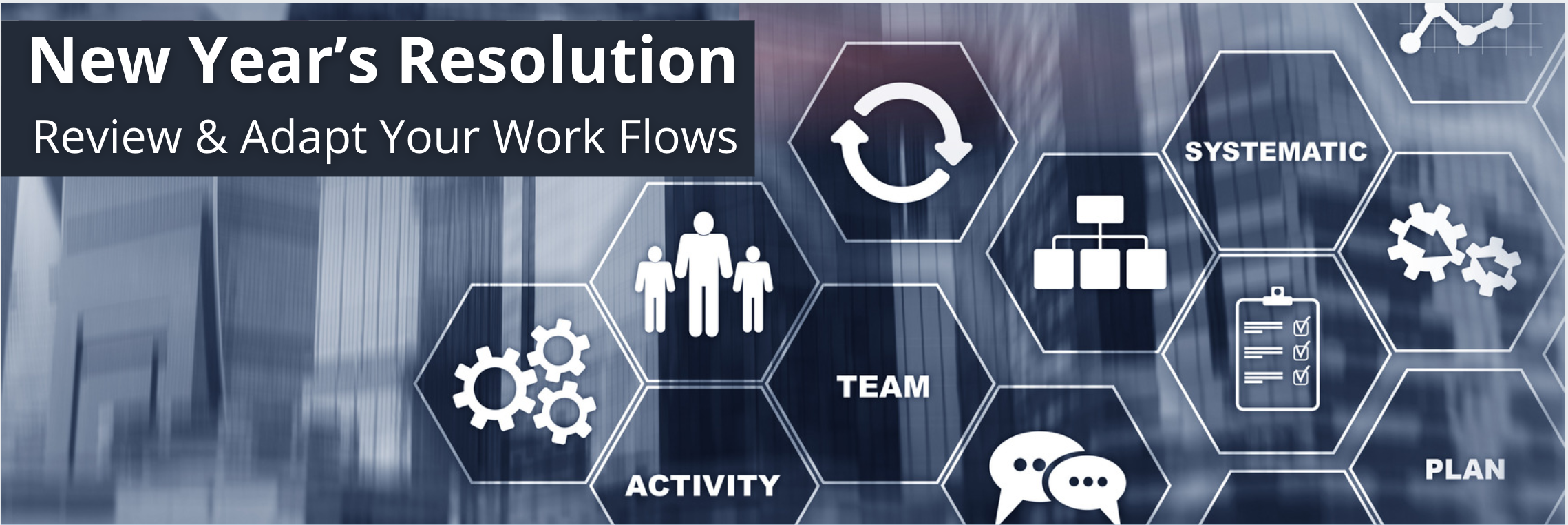New Year’s Resolution #1: Review and Adapt Your Work Flows


Work’flow: ‘A collection of fixed tasks or sequences performed to accomplish a business process according to a set of predefined rules.’
Workflows are an essential element in any organization, allowing work teams to complete tasks with less manual input systematically. Ideally, this should help your team members have more availability to work on tasks that require more individual attention.
But regardless of how elegantly a workflow was originally designed, it may become less effective over time, causing lags that show up as delayed internal processes, reduced customer service, or increased time spent manually overriding the workflow. For example, let’s say that a particular workflow relies on input from an external department overhauled in a recent merger. Without that input, the workflow is likely to become bogged down and should be changed.
When you improve old business processes, you can utilize your resources more efficiently, and your employees can work more strategically. This is especially true in bottleneck scenarios. Particularly with old business processes, many stakeholders could be performing tasks that are no longer needed. When your business becomes leaner, then task-associated costs may also go down.
Therefore, it’s important to review your workflows at least once a year to ensure that they’re viable and pertinent to the way things still work. Here are some tips for reviewing and improving workflow efficiency:
Collect hard data.
While not an exhaustive list, you want to look at some of these items:
- Number of items in the workflow initiated over a specific period
- Number of items completed
- Amount of time taken to complete each task
- Number of times a task is sent back or rejected
- Number of times an item requires extra clarification
If, for example, you find that the many items are sent back for extra clarification and require manual resolution, then you may want to build a step into the workflow that addresses all the possible clarification criteria.
Collect soft data.
Ask for feedback from existing staff and users about what frustrates them in the day and what works well. Inventory the entire office, from the filing system to the network systems. Assess the age and ability of computer hardware, software, and phone systems. Evaluate the use of paper in the office, including how forms are used, processed, and archived. You may find that an older computer network is delaying deliverables to your users or that your files are poorly named, causing longer-than-average retrieval times.
Look at the big picture.
Determine why a workflow exists. Is it to speed up a process, or to minimize errors? Is the original workflow still relevant? How does it add value to the strategy of the company at this point in time?
Who are the stakeholders? Do they still exist? Is each step really needed? Can we bring in more automation? By marking down the areas for improvement and removing the inefficient steps from your processes, you will be able to create a process that’s in its ideal state.
Once you’ve got an overall picture of your workflows based on your initial review, consider the following as you consider revising them:
- Use ‘recipe cards’ to outline the steps to refine a new work process. List out “ingredients’ such as hours necessary to complete a project, the tools needed, and the type of content required. Ensure you involve stakeholders at appropriate steps and test the process at various stages among various users.
Make documentation and knowledge sharing a priority.
- Choose a workflow management tool that allows you to manage and share files and documents among all appropriate stakeholders.
- Choose a workflow process that incorporates staff management and communication, making it easier for team members to stay on the same page. This will allow staff to connect easily with the team—avoid manual engagement such as emails and calendaring—and allow you to circumvent any loss in the output should someone leave the department. In fact, surveys suggest that employees are interrupted by email every five minutes, slowing down productivity and making it a less effective communication channel for immediate decisions.
- Prepare your team to adjust. Change the processes based on your results. Notify all stakeholders of any change, and let them know if there will be any downtime or how to handle items in the middle of a changed workflow.
Once you have the new process in place, provide training, and explain that the new process is there to help everyone be happier and more productive. New procedures do take time to implement, so be patient, as employees might revert to old, comfortable ways at times. Remind them of the process, and track it. You might find the new method works brilliantly, but most of the time, you’ll need to make adjustments along the way.